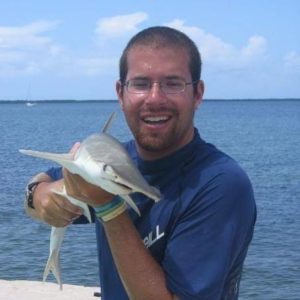Bonnethead sharks, one of the smallest members of the hammerhead shark family Sphyrnidae, have a special place in my heart. For many years, the avatar I used for science communication efforts, including posts on this blog, was a picture of me with a bonnethead.

These sharks, which can grow up to about 5 feet long, are found throughout North, Central, and South America. However, new research by Fields and friends suggests that they may actually be a species complex, not a true species. “A species complex is a group of distinct species that are incorrectly classified as one species because they look very similar to one another,” explained Dr. Demian Chapman, an Associate Professor of Biology at Florida International University and a co-author on this new study. “A great example is the white spotted eagle ray (Aetobatus narinari) that was once thought to be one, globally distributed species, but now has been shown to be a group of very similar-looking species, each of which lives in a particular region.”
According to Dr. Chapman, sometimes you can only tell the difference between similar-looking species by comparing their DNA. “DNA sequences within a species change slowly over time via a natural process known as mutation. If some members of a species stop breeding with the rest, then each group will develop its own, unique mutations over time. As time passes the groups eventually become genetically distinct species that are incapable of breeding. Sometimes this process involves a great deal of change to DNA sequences without substantial change in the body form of the two species, which is how cryptic species arise.” One recent example of a cryptic species is the Carolina Hammerhead, a cryptic species now considered to be a separate species from externally identical-looking Scalloped Hammerheads.
That appears to be what happened in the case of bonnethead sharks in the greater Caribbean. “My student [and lead author on this paper] Andrew Fields was looking at how many populations of bonnetheads lived in an area stretching from the Bahamas, the U.S. coast from the Carolinas to Texas, through to Belize,” Dr. Chapman said. “When we looked at their DNA sequences the animals from Belize stood out as being highly distinct from the ones in the U.S. and Bahamas, even though the animals themselves looked identical to each other. Our analyses indicate the Belize bonnetheads haven’t bred with the ones in the U.S. or Bahamas for millions of years. That’s when we knew we were dealing with a species complex rather than one species of bonnethead shark living all the way from the Carolinas to Brazil.”

This discovery may have implications for the conservation and management of this species. Bonnethead populations are currently thought of as relatively healthy, but that’s when you include all of the individuals together as one species. “If they actually consist of multiple species with smaller ranges that are fewer in number then we will need to assess each one of these species individually,” Dr. Chapman said. “I suspect the bonnetheads of the U.S. and Bahamas would remain in the least concern category because they are well studied and managed, but we know much less about these animals in the Caribbean and South America except that fisheries are taking them in large quantities and management is very limited in these regions. So the bonnetheads in some of these locations may be worse off and in need of stricter management attention.”
*Author’s note: Bonnethead sharks are one of the smallest hammerhead shark species, but not the smallest. The headline and first sentence have been adjusted to reflect that.*

I got to host Ron and Valerie Taylor in the Bahamas once and Valerie commented that the Lemon Sharks in the Caribbean had a tiny difference from the Lemons in Australia. So, maybe this implies another species complex? Just popping it out there…
Hi Greg! I think that the species of lemon sharks in the Caribbean (Negaprion brevirostris) is different from the species of lemon shark in Australia (Negaprion acutidens)